Jupyter Snippet NP ch11-code-listing
Jupyter Snippet NP ch11-code-listing
Chapter 11: Partial differential equations
Robert Johansson
Source code listings for Numerical Python - Scientific Computing and Data Science Applications with Numpy, SciPy and Matplotlib (ISBN 978-1-484242-45-2).
import numpy as np
%matplotlib inline
%config InlineBackend.figure_format='retina'
import matplotlib.pyplot as plt
import matplotlib as mpl
import mpl_toolkits.mplot3d
import scipy.sparse as sp
import scipy.sparse.linalg
import scipy.linalg as la
Finite-difference method
1d example
Heat equation:
$$-5 = u_{xx}, u(x=0) = 1, u(x=1) = 2$$
$$ u_{xx}[n] = (u[n-1] - 2u[n] + u[n+1])/dx^2 $$
N = 5
u0 = 1
u1 = 2
dx = 1.0 / (N + 1)
A = (np.eye(N, k=-1) - 2 * np.eye(N) + np.eye(N, k=1)) / dx**2
A
array([[-72., 36., 0., 0., 0.],
[ 36., -72., 36., 0., 0.],
[ 0., 36., -72., 36., 0.],
[ 0., 0., 36., -72., 36.],
[ 0., 0., 0., 36., -72.]])
d = -5 * np.ones(N)
d[0] -= u0 / dx**2
d[N-1] -= u1 / dx**2
u = np.linalg.solve(A, d)
x = np.linspace(0, 1, N+2)
U = np.hstack([[u0], u, [u1]])
fig, ax = plt.subplots(figsize=(8, 4))
ax.plot(x, U)
ax.plot(x[1:-1], u, 'ks')
ax.set_xlim(0, 1)
ax.set_xlabel(r"$x$", fontsize=18)
ax.set_ylabel(r"$u(x)$", fontsize=18)
fig.savefig("ch11-fdm-1d.pdf")
fig.tight_layout();
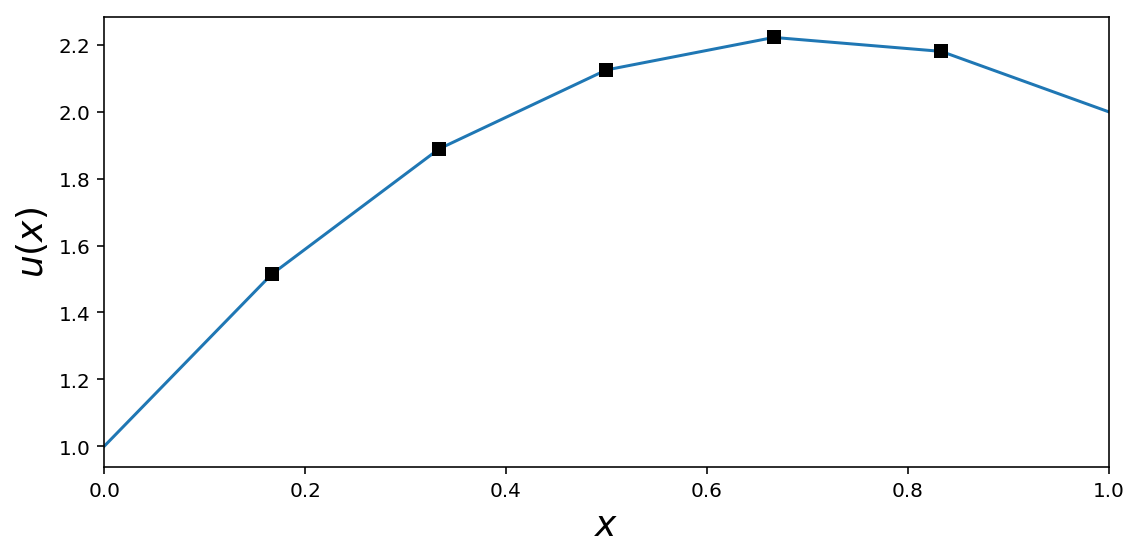
2d example
laplace equation: $u_{xx} + u_{yy} = 0$
on boundary:
$$ u(x=0) = u(x=1) = u(y = 0) = u(y = 1) = 10 $$
$$ u_{xx}[m, n] = (u[m-1, n] - 2u[m,n] + u[m+1,n])/dx^2 $$
$$ u_{yy}[m, n] = (u[m, n-1] - 2u[m,n] + u[m,n+1])/dy^2 $$
final equation
$$ 0
(u[m-1 + N n] - 2u[m + N n] + u[m+1 + N n])/dx^2 + (u[m + N (n-1)] - 2u[m + N n] + u[m + N(n+1]))/dy^2
(u[m + N n -1] - 2u[m + N n] + u[m + N n + 1])/dx^2 + (u[m + N n -N)] - 2u[m + N n] + u[m + N n + N]))/dy^2 $$
N = 100
u0_t, u0_b = 5, -5
u0_l, u0_r = 3, -1
dx = 1. / (N+1)
A_1d = (sp.eye(N, k=-1) + sp.eye(N, k=1) - 4 * sp.eye(N))/dx**2
A = sp.kron(sp.eye(N), A_1d) + (sp.eye(N**2, k=-N) + sp.eye(N**2, k=N))/dx**2
A
<10000x10000 sparse matrix of type '<class 'numpy.float64'>'
with 49600 stored elements in Compressed Sparse Row format>
A.nnz * 1.0/ np.prod(A.shape) * 2000
0.992
d = np.zeros((N, N))
d[0, :] += -u0_b
d[-1, :] += -u0_t
d[:, 0] += -u0_l
d[:, -1] += -u0_r
d = d.reshape(N**2) / dx**2
u = sp.linalg.spsolve(A, d).reshape(N, N)
U = np.vstack([np.ones((1, N+2)) * u0_b,
np.hstack([np.ones((N, 1)) * u0_l, u, np.ones((N, 1)) * u0_r]),
np.ones((1, N+2)) * u0_t])
fig, ax = plt.subplots(1, 1, figsize=(8, 6))
x = np.linspace(0, 1, N+2)
X, Y = np.meshgrid(x, x)
c = ax.pcolor(X, Y, U, vmin=-5, vmax=5, cmap=mpl.cm.get_cmap('RdBu_r'))
cb = plt.colorbar(c, ax=ax)
ax.set_xlabel(r"$x_1$", fontsize=18)
ax.set_ylabel(r"$x_2$", fontsize=18)
cb.set_label(r"$u(x_1, x_2)$", fontsize=18)
fig.savefig("ch11-fdm-2d.pdf")
fig.tight_layout()
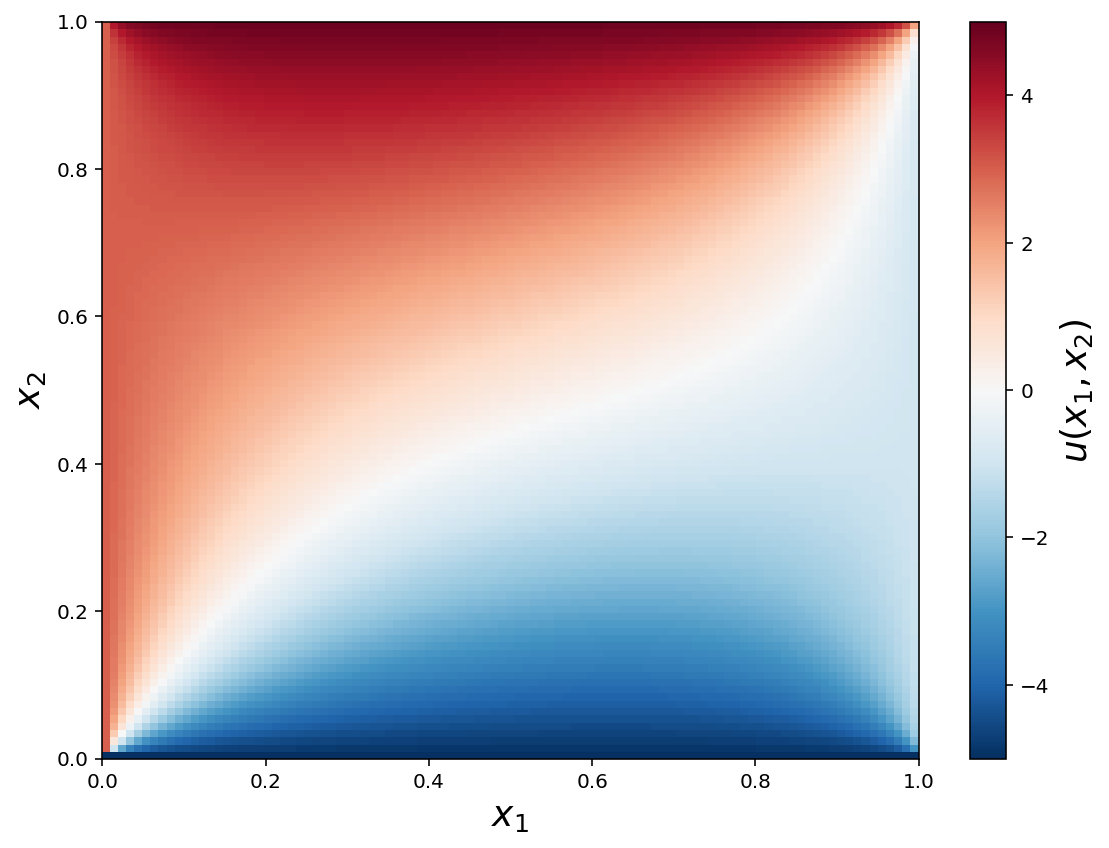
x = np.linspace(0, 1, N+2)
X, Y = np.meshgrid(x, x)
fig = plt.figure(figsize=(12, 5.5))
cmap = mpl.cm.get_cmap('RdBu_r')
ax = fig.add_subplot(1, 2, 1)
p = ax.pcolor(X, Y, U, vmin=-5, vmax=5, cmap=cmap)
ax.set_xlabel(r"$x_1$", fontsize=18)
ax.set_ylabel(r"$x_2$", fontsize=18)
ax = fig.add_subplot(1, 2, 2, projection='3d')
p = ax.plot_surface(X, Y, U, vmin=-5, vmax=5, rstride=3, cstride=3, linewidth=0, cmap=cmap)
ax.set_xlabel(r"$x_1$", fontsize=16)
ax.set_ylabel(r"$x_2$", fontsize=16)
cb = plt.colorbar(p, ax=ax, shrink=0.75)
cb.set_label(r"$u(x_1, x_2)$", fontsize=18)
fig.savefig("ch11-fdm-2d.pdf")
fig.savefig("ch11-fdm-2d.png")
fig.tight_layout()
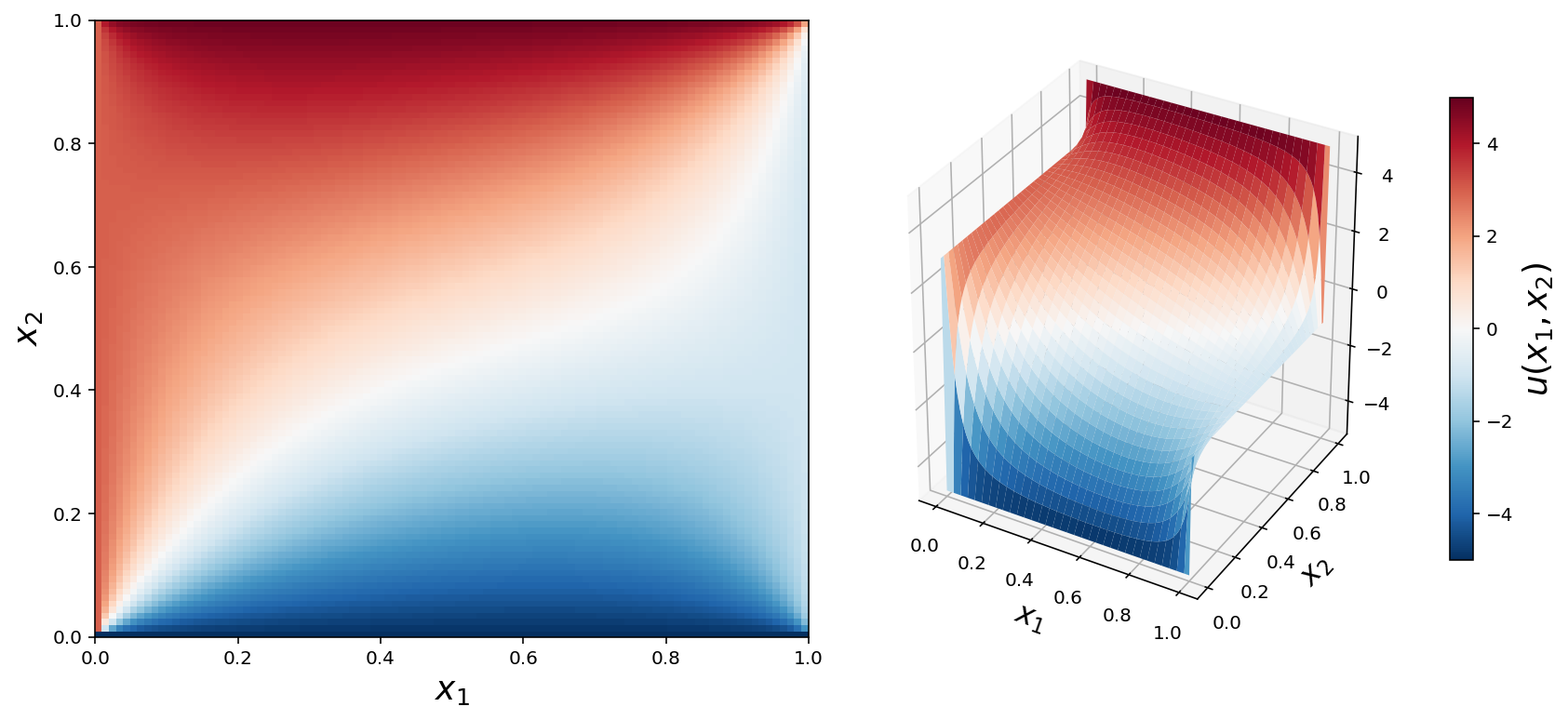
Compare performance when using dense/sparse matrices
A_dense = A.todense()
%timeit np.linalg.solve(A_dense, d)
15.9 s ± 904 ms per loop (mean ± std. dev. of 7 runs, 1 loop each)
%timeit la.solve(A_dense, d)
18.3 s ± 872 ms per loop (mean ± std. dev. of 7 runs, 1 loop each)
%timeit sp.linalg.spsolve(A, d)
58.7 ms ± 3.17 ms per loop (mean ± std. dev. of 7 runs, 10 loops each)
10.8 / 31.9e-3
338.5579937304076
2d example with source term
d = - np.ones((N, N))
d = d.reshape(N**2)
u = sp.linalg.spsolve(A, d).reshape(N, N)
U = np.vstack([np.zeros((1, N+2)),
np.hstack([np.zeros((N, 1)), u, np.zeros((N, 1))]),
np.zeros((1, N+2))])
x = np.linspace(0, 1, N+2)
X, Y = np.meshgrid(x, x)
fig, ax = plt.subplots(1, 1, figsize=(8, 6), subplot_kw={'projection': '3d'})
p = ax.plot_surface(X, Y, U, rstride=4, cstride=4, linewidth=0, cmap=mpl.cm.get_cmap("Reds"))
cb = fig.colorbar(p, shrink=0.5)
ax.set_xlabel(r"$x_1$", fontsize=18)
ax.set_ylabel(r"$x_2$", fontsize=18)
cb.set_label(r"$u(x_1, x_2)$", fontsize=18)
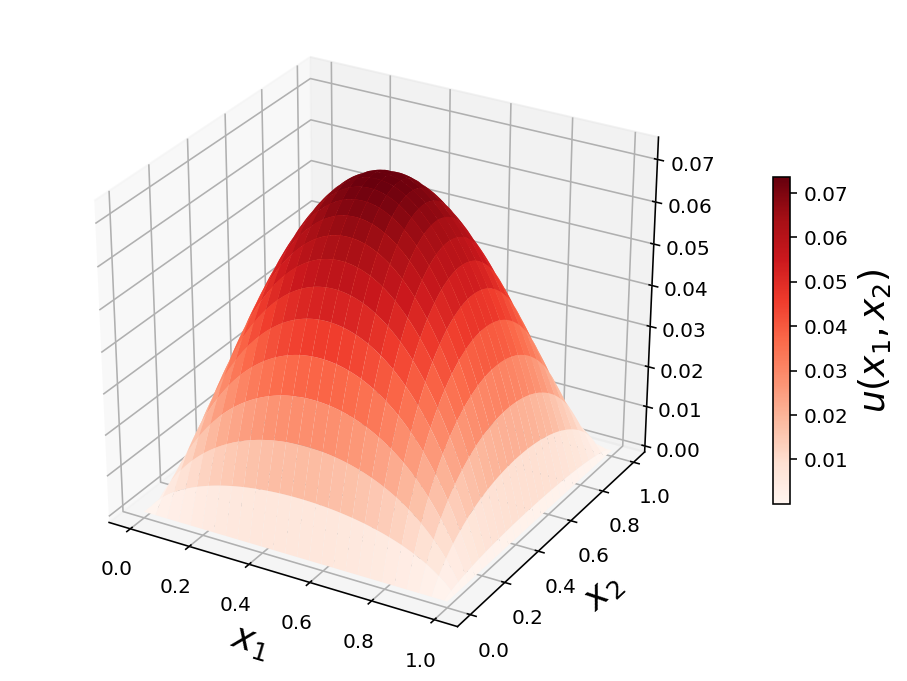
FEniCS
import dolfin
import mshr
dolfin.parameters["reorder_dofs_serial"] = False
dolfin.parameters["allow_extrapolation"] = True
N1 = N2 = 75
mesh = dolfin.RectangleMesh(dolfin.Point(0, 0), dolfin.Point(1, 1), N1, N2)
from IPython.display import display
dolfin.RectangleMesh(dolfin.Point(0, 0), dolfin.Point(1, 1), 10, 10)
Function space from mesh
V = dolfin.FunctionSpace(mesh, 'Lagrange', 1)
Variational problem
u = dolfin.TrialFunction(V)
v = dolfin.TestFunction(V)
a = dolfin.inner(dolfin.nabla_grad(u), dolfin.nabla_grad(v)) * dolfin.dx
f1 = dolfin.Constant(1.0)
L1 = f1 * v * dolfin.dx
f2 = dolfin.Constant(1.0)
# f2 = dolfin.Expression("x[0]*x[0] + x[1]*x[1]", degree=1)
L2 = f2 * v * dolfin.dx
Boundary conditions
u0 = dolfin.Constant(0)
def u0_boundary(x, on_boundary):
# try to pin down the function at some interior region:
#if np.sqrt((x[0]-0.5)**2 + (x[1]-0.5)**2) < 0.1:
# return True
return on_boundary
bc = dolfin.DirichletBC(V, u0, u0_boundary)
Solve the problem
A = dolfin.assemble(a)
Calling FFC just-in-time (JIT) compiler, this may take some time.
Calling FFC just-in-time (JIT) compiler, this may take some time.
/Users/rob/miniconda3/envs/py3.6/lib/python3.6/site-packages/ffc/uflacs/analysis/dependencies.py:61: FutureWarning: Using a non-tuple sequence for multidimensional indexing is deprecated; use `arr[tuple(seq)]` instead of `arr[seq]`. In the future this will be interpreted as an array index, `arr[np.array(seq)]`, which will result either in an error or a different result.
active[targets] = 1
Calling FFC just-in-time (JIT) compiler, this may take some time.
Calling FFC just-in-time (JIT) compiler, this may take some time.
b = dolfin.assemble(L1)
Calling FFC just-in-time (JIT) compiler, this may take some time.
Calling FFC just-in-time (JIT) compiler, this may take some time.
/Users/rob/miniconda3/envs/py3.6/lib/python3.6/site-packages/ffc/uflacs/analysis/dependencies.py:61: FutureWarning: Using a non-tuple sequence for multidimensional indexing is deprecated; use `arr[tuple(seq)]` instead of `arr[seq]`. In the future this will be interpreted as an array index, `arr[np.array(seq)]`, which will result either in an error or a different result.
active[targets] = 1
bc.apply(A, b)
u_sol1 = dolfin.Function(V)
dolfin.solve(A, u_sol1.vector(), b)
1
u_sol2 = dolfin.Function(V)
dolfin.solve(a == L2, u_sol2, bc)
Dolfin plot
dolfin.plot(u_sol1)
# dolfin.interactive()
<matplotlib.tri.tricontour.TriContourSet at 0xa568c1c18>
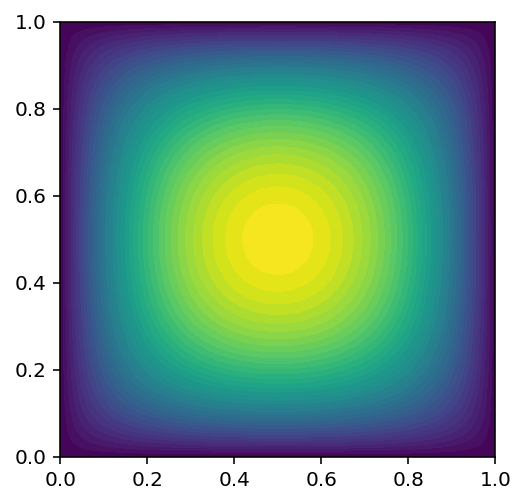
Save VTK files
dolfin.File('u_sol1.pvd') << u_sol1
dolfin.File('u_sol2.pvd') << u_sol2
f = dolfin.File('combined.pvd')
f << mesh
f << u_sol1
f << u_sol2
Function evaluation
u_sol1([0.21, 0.67])
0.04660769977813516
Obtain NumPy arrays
u_mat1 = np.array(u_sol1.vector()).reshape(N1+1, N2+1)
u_mat2 = np.array(u_sol2.vector()).reshape(N1+1, N2+1)
X, Y = np.meshgrid(np.linspace(0, 1, N1+2), np.linspace(0, 1, N2+2))
fig, (ax1, ax2) = plt.subplots(1, 2, figsize=(12, 5))
cmap = mpl.cm.get_cmap('Reds')
c = ax1.pcolor(X, Y, u_mat1, cmap=cmap)
cb = plt.colorbar(c, ax=ax1)
ax1.set_xlabel(r"$x$", fontsize=18)
ax1.set_ylabel(r"$y$", fontsize=18)
cb.set_label(r"$u(x, y)$", fontsize=18)
cb.set_ticks([0.0, 0.02, 0.04, 0.06])
c = ax2.pcolor(X, Y, u_mat2, cmap=cmap)
cb = plt.colorbar(c, ax=ax2)
ax1.set_xlabel(r"$x$", fontsize=18)
ax1.set_ylabel(r"$y$", fontsize=18)
cb.set_label(r"$u(x, y)$", fontsize=18)
cb.set_ticks([0.0, 0.02, 0.04])
fig.savefig("ch11-fdm-2d-ex1.pdf")
fig.savefig("ch11-fdm-2d-ex1.png")
fig.tight_layout()
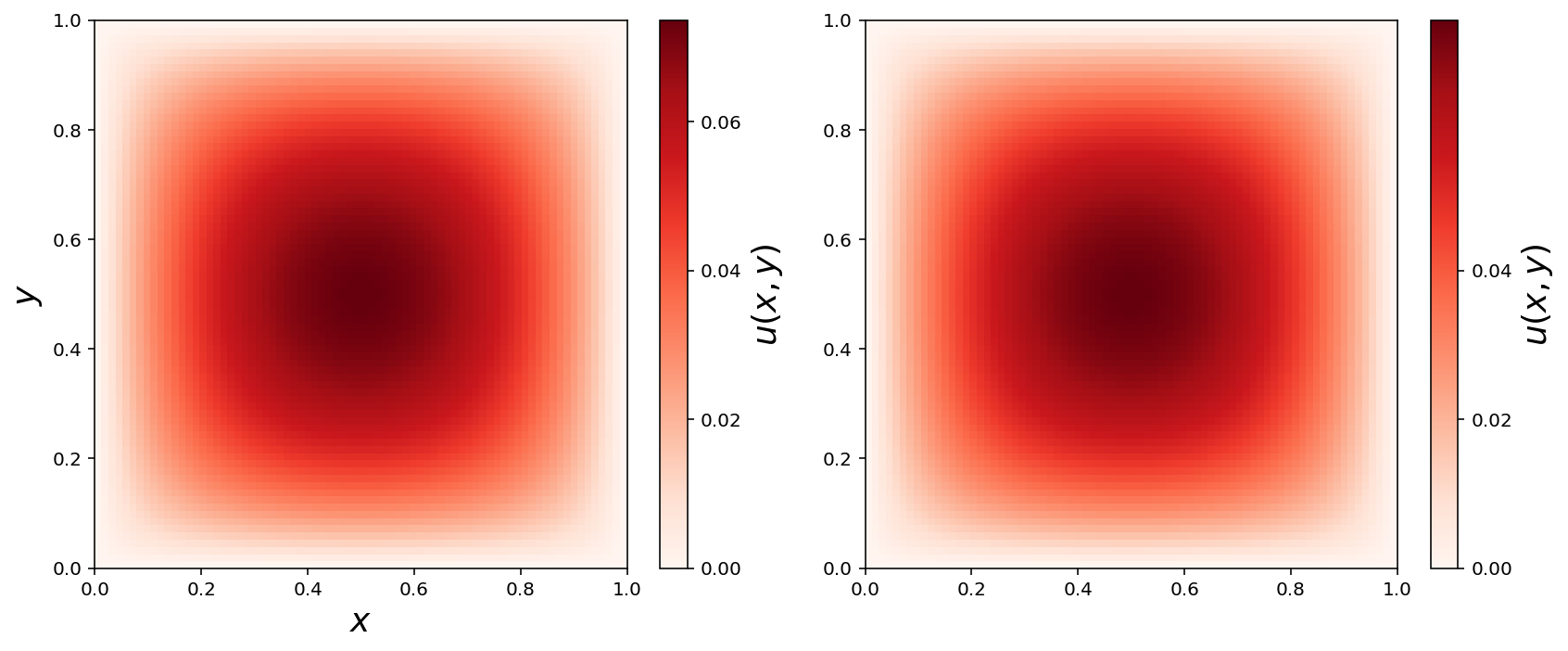
X, Y = np.meshgrid(np.linspace(0, 1, N1+1), np.linspace(0, 1, N2+1))
fig, (ax1, ax2) = plt.subplots(1, 2, figsize=(16, 6), subplot_kw={'projection': '3d'})
p = ax1.plot_surface(X, Y, u_mat1, rstride=4, cstride=4, linewidth=0, cmap=mpl.cm.get_cmap("Reds"))
cb = fig.colorbar(p, ax=ax1, shrink=0.5)
ax1.set_xlabel(r"$x_1$", fontsize=18)
ax1.set_ylabel(r"$x_2$", fontsize=18)
cb.set_label(r"$u(x_1, x_2)$", fontsize=18)
p = ax2.plot_surface(X, Y, u_mat2, rstride=4, cstride=4, linewidth=0, cmap=mpl.cm.get_cmap("Reds"))
cb = fig.colorbar(p, ax=ax2, shrink=0.5)
ax2.set_xlabel(r"$x_1$", fontsize=18)
ax2.set_ylabel(r"$x_2$", fontsize=18)
cb.set_label(r"$u(x_1, x_2)$", fontsize=18)
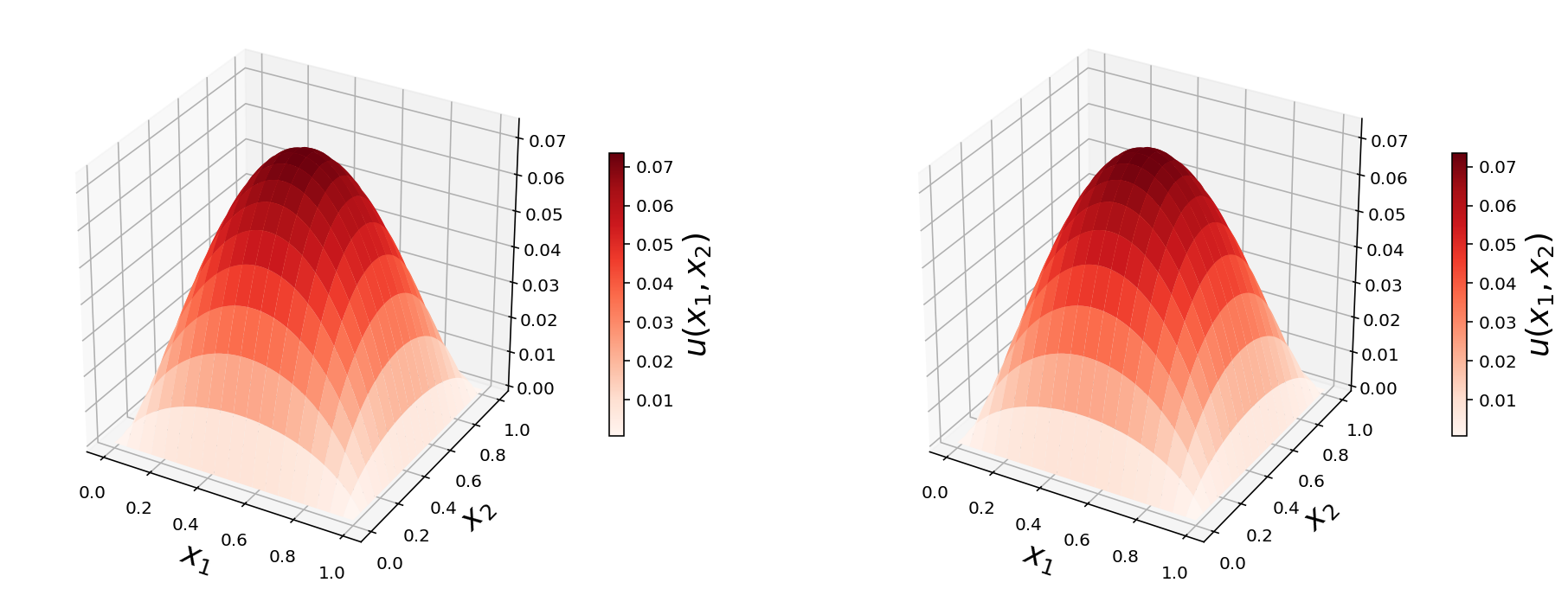
Triangulation
def mesh_triangulation(mesh):
coordinates = mesh.coordinates()
triangles = mesh.cells()
triangulation = mpl.tri.Triangulation(coordinates[:, 0], coordinates[:, 1], triangles)
return triangulation
triangulation = mesh_triangulation(mesh)
fig, (ax1, ax2) = plt.subplots(1, 2, figsize=(10, 4))
ax1.triplot(triangulation)
ax1.set_xlabel(r"$x$", fontsize=18)
ax1.set_ylabel(r"$y$", fontsize=18)
c = ax2.tripcolor(triangulation, np.array(u_sol2.vector()), cmap=cmap)
cb = plt.colorbar(c, ax=ax2)
ax2.set_xlabel(r"$x$", fontsize=18)
ax2.set_ylabel(r"$y$", fontsize=18)
cb.set_label(r"$u(x, y)$", fontsize=18)
cb.set_ticks([0.0, 0.02, 0.04])
fig.savefig("ch11-fdm-2d-ex2.pdf")
fig.savefig("ch11-fdm-2d-ex2.png")
fig.tight_layout()
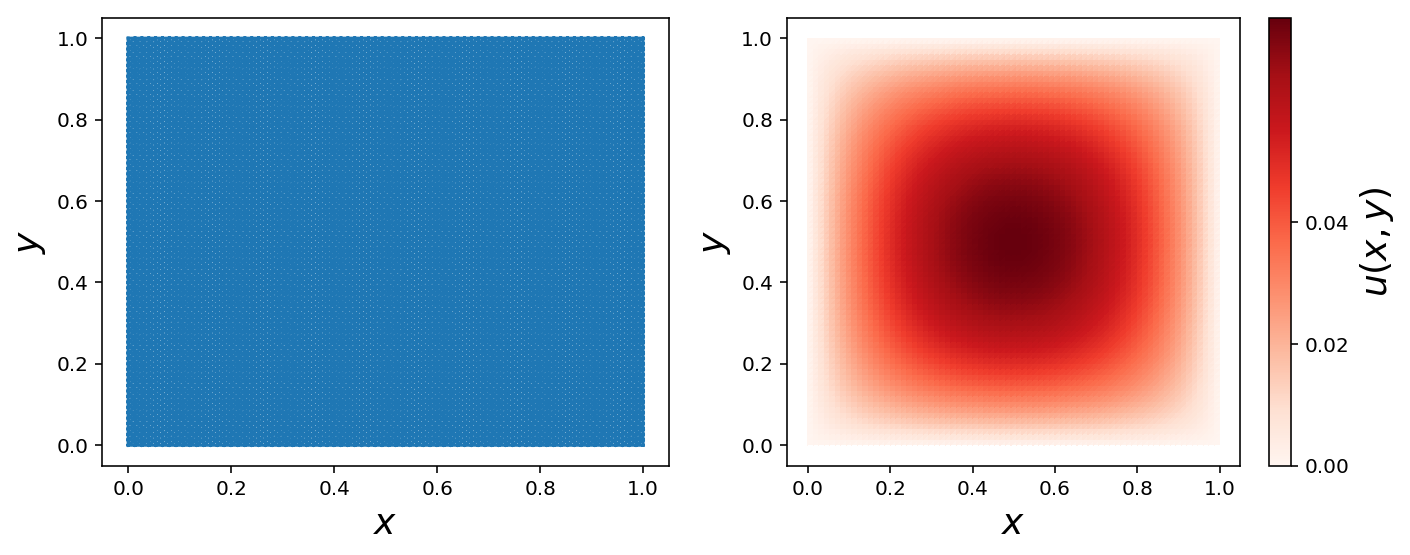
Dirichlet boundary conditions
N1 = N2 = 75
mesh = dolfin.RectangleMesh(dolfin.Point(0, 0), dolfin.Point(1, 1), N1, N2)
V = dolfin.FunctionSpace(mesh, 'Lagrange', 1)
u = dolfin.TrialFunction(V)
v = dolfin.TestFunction(V)
a = dolfin.inner(dolfin.nabla_grad(u), dolfin.nabla_grad(v)) * dolfin.dx
f = dolfin.Constant(0.0)
L = f * v * dolfin.dx
def u0_top_boundary(x, on_boundary):
return on_boundary and abs(x[1]-1) < 1e-8
def u0_bottom_boundary(x, on_boundary):
return on_boundary and abs(x[1]) < 1e-8
def u0_left_boundary(x, on_boundary):
return on_boundary and abs(x[0]) < 1e-8
def u0_right_boundary(x, on_boundary):
return on_boundary and abs(x[0]-1) < 1e-8
bc_t = dolfin.DirichletBC(V, dolfin.Constant(5), u0_top_boundary)
bc_b = dolfin.DirichletBC(V, dolfin.Constant(-5), u0_bottom_boundary)
bc_l = dolfin.DirichletBC(V, dolfin.Constant(3), u0_left_boundary)
bc_r = dolfin.DirichletBC(V, dolfin.Constant(-1), u0_right_boundary)
bcs = [bc_t, bc_b, bc_r, bc_l]
u_sol = dolfin.Function(V)
dolfin.solve(a == L, u_sol, bcs)
u_mat = np.array(u_sol.vector()).reshape(N1+1, N2+1)
x = np.linspace(0, 1, N1+2)
y = np.linspace(0, 1, N1+2)
X, Y = np.meshgrid(x, y)
fig, ax = plt.subplots(1, 1, figsize=(8, 6))
c = ax.pcolor(X, Y, u_mat, vmin=-5, vmax=5, cmap=mpl.cm.get_cmap('RdBu_r'))
cb = plt.colorbar(c, ax=ax)
ax.set_xlabel(r"$x_1$", fontsize=18)
ax.set_ylabel(r"$x_2$", fontsize=18)
cb.set_label(r"$u(x_1, x_2)$", fontsize=18)
fig.savefig("ch11-fdm-2d-ex3.pdf")
fig.savefig("ch11-fdm-2d-ex3.png")
fig.tight_layout()
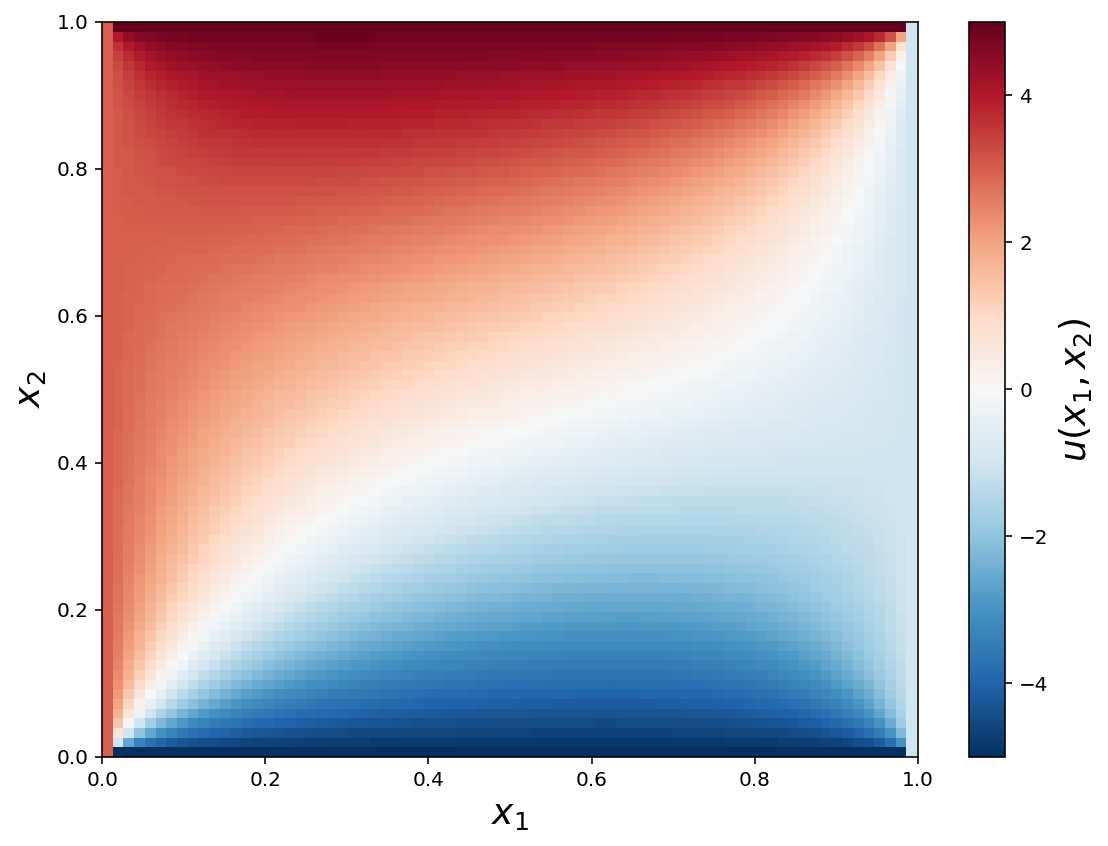
Circular geometry
r_outer = 1
r_inner = 0.25
r_middle = 0.1
x0, y0 = 0.4, 0.4
domain = mshr.Circle(dolfin.Point(.0, .0), r_outer) \
- mshr.Circle(dolfin.Point(.0, .0), r_inner) \
- mshr.Circle(dolfin.Point( x0, y0), r_middle) \
- mshr.Circle(dolfin.Point( x0, -y0), r_middle) \
- mshr.Circle(dolfin.Point(-x0, y0), r_middle) \
- mshr.Circle(dolfin.Point(-x0, -y0), r_middle)
mesh = mshr.generate_mesh(domain, 10)
mesh
V = dolfin.FunctionSpace(mesh, 'Lagrange', 1)
u = dolfin.TrialFunction(V)
v = dolfin.TestFunction(V)
a = dolfin.inner(dolfin.nabla_grad(u), dolfin.nabla_grad(v)) * dolfin.dx
f = dolfin.Constant(1.0)
L = f * v * dolfin.dx
def u0_outer_boundary(x, on_boundary):
x, y = x[0], x[1]
return on_boundary and abs(np.sqrt(x**2 + y**2) - r_outer) < 5e-2
def u0_inner_boundary(x, on_boundary):
x, y = x[0], x[1]
return on_boundary and abs(np.sqrt(x**2 + y**2) - r_inner) < 5e-2
def u0_middle_boundary(x, on_boundary):
x, y = x[0], x[1]
if on_boundary:
for _x0 in [-x0, x0]:
for _y0 in [-y0, y0]:
if abs(np.sqrt((x+_x0)**2 + (y+_y0)**2) - r_middle) < 5e-2:
return True
return False
bc_inner = dolfin.DirichletBC(V, dolfin.Constant(15), u0_inner_boundary)
bc_middle = dolfin.DirichletBC(V, dolfin.Constant(0), u0_middle_boundary)
bcs = [bc_inner, bc_middle]
u_sol = dolfin.Function(V)
dolfin.solve(a == L, u_sol, bcs)
triangulation = mesh_triangulation(mesh)
fig, (ax1, ax2) = plt.subplots(1, 2, figsize=(10, 4))
ax1.triplot(triangulation)
ax1.set_xlabel(r"$x$", fontsize=18)
ax1.set_ylabel(r"$y$", fontsize=18)
c = ax2.tripcolor(triangulation, np.array(u_sol.vector()), cmap=mpl.cm.get_cmap("Reds"))
cb = plt.colorbar(c, ax=ax2)
ax2.set_xlabel(r"$x$", fontsize=18)
ax2.set_ylabel(r"$y$", fontsize=18)
cb.set_label(r"$u(x, y)$", fontsize=18)
cb.set_ticks([0.0, 5, 10, 15])
fig.savefig("ch11-fdm-2d-ex4.pdf")
fig.savefig("ch11-fdm-2d-ex4.png")
fig.tight_layout()
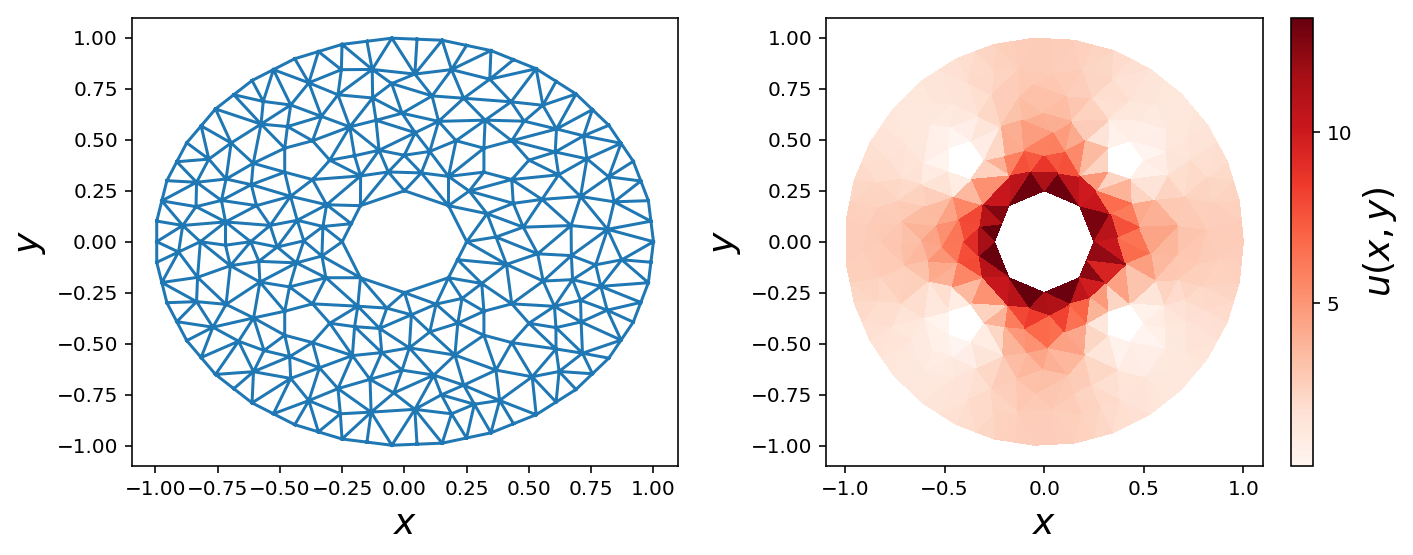
Post processing
outer_boundary = dolfin.AutoSubDomain(lambda x, on_bnd: on_bnd and abs(np.sqrt(x[0]**2 + x[1]**2) - r_outer) < 5e-2)
bc_outer = dolfin.DirichletBC(V, 1, outer_boundary)
mask_outer = dolfin.Function(V)
bc_outer.apply(mask_outer.vector())
u_outer = u_sol.vector()[mask_outer.vector() == 1]
x_outer = mesh.coordinates()[mask_outer.vector() == 1]
phi = np.angle(x_outer[:, 0] + 1j * x_outer[:, 1])
order = np.argsort(phi)
fig, ax = plt.subplots(1, 1, figsize=(8, 4))
ax.plot(phi[order], u_outer[order], 's-', lw=2)
ax.set_ylabel(r"$u(x,y)$ at $x^2+y^2=1$", fontsize=18)
ax.set_xlabel(r"$\phi$", fontsize=18)
ax.set_xlim(-np.pi, np.pi)
fig.tight_layout()
fig.savefig("ch11-fem-2d-ex5.pdf")
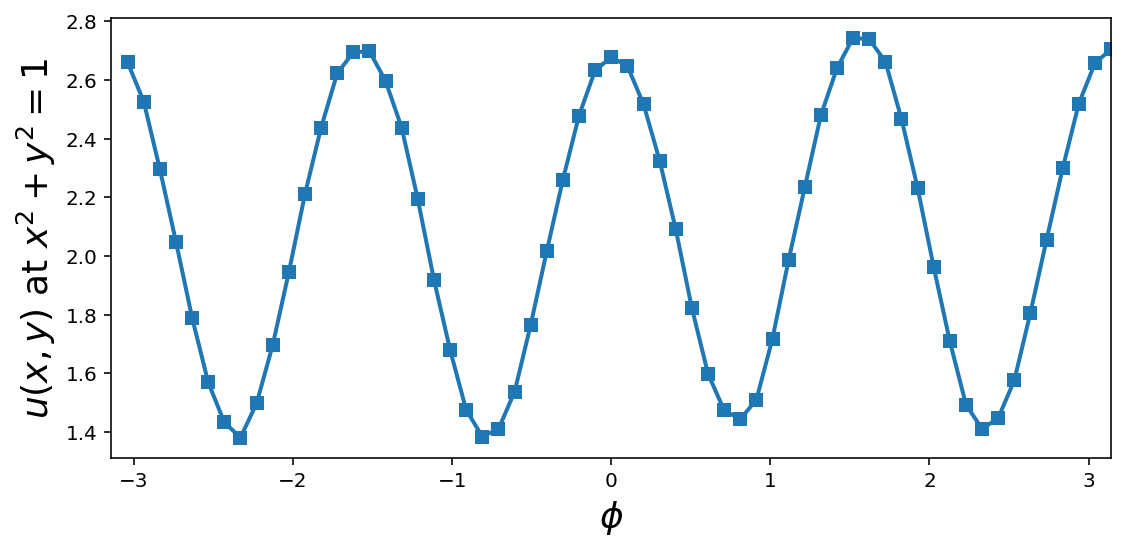
Mesh refining
domain = mshr.Circle(dolfin.Point(.0, .0), 1.0) - mshr.Rectangle(dolfin.Point(0.0, -1.0), dolfin.Point(1.0, 0.0))
mesh = mshr.generate_mesh(domain, 10)
refined_mesh = mesh
for r in [0.5, 0.25]:
cell_markers = dolfin.MeshFunction("bool", refined_mesh, 2)
cell_markers.set_all(False)
for cell in dolfin.cells(refined_mesh):
if cell.distance(dolfin.Point(.0, .0)) < r:
cell_markers[cell] = True
refined_mesh = dolfin.refine(refined_mesh, cell_markers)
fig, (ax1, ax2) = plt.subplots(1, 2, figsize=(8, 4))
ax1.triplot(mesh_triangulation(mesh))
ax2.triplot(mesh_triangulation(refined_mesh))
for ax in [ax1, ax2]:
for side in ['bottom','right','top','left']:
ax.spines[side].set_visible(False)
ax.set_xticks([])
ax.set_yticks([])
ax.xaxis.set_ticks_position('none')
ax.yaxis.set_ticks_position('none')
ax.set_xlabel(r"$x$", fontsize=18)
ax.set_ylabel(r"$y$", fontsize=18)
fig.savefig("ch11-fem-2d-mesh-refine.pdf")
fig.savefig("ch11-fem-2d-mesh-refine.png")
fig.tight_layout()
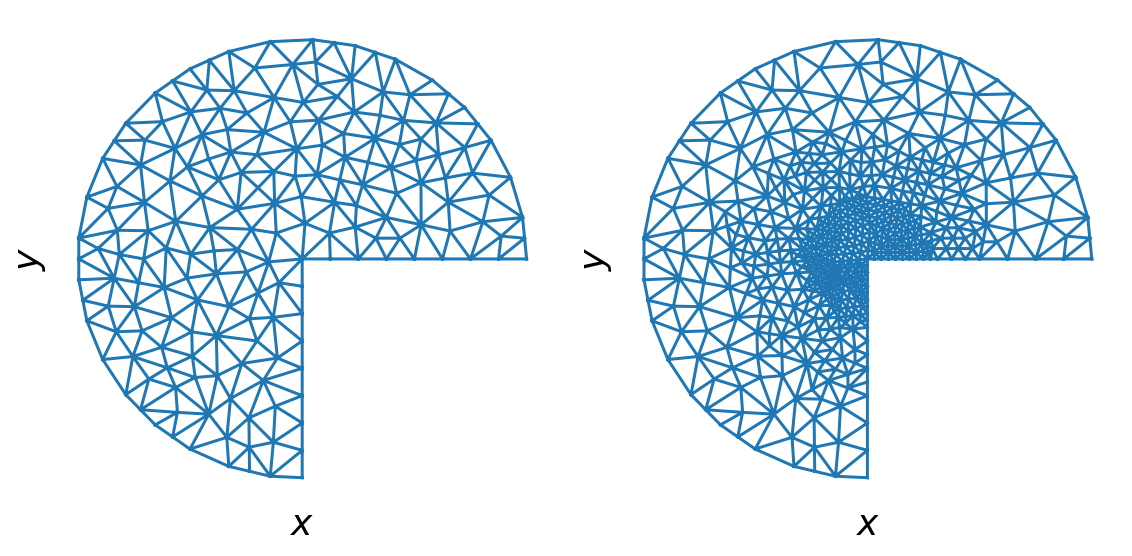
Refined mesh with Dirichlet boundary conditions
mesh = refined_mesh
V = dolfin.FunctionSpace(mesh, 'Lagrange', 1)
u = dolfin.TrialFunction(V)
v = dolfin.TestFunction(V)
a = dolfin.inner(dolfin.nabla_grad(u), dolfin.nabla_grad(v)) * dolfin.dx
f = dolfin.Constant(0.0)
L = f * v * dolfin.dx
def u0_vertical_boundary(x, on_boundary):
x, y = x[0], x[1]
return on_boundary and abs(x) < 1e-2 and y < 0.0
def u0_horizontal_boundary(x, on_boundary):
x, y = x[0], x[1]
return on_boundary and abs(y) < 1e-2 and x > 0.0
bc_vertical = dolfin.DirichletBC(V, dolfin.Constant(-5), u0_vertical_boundary)
bc_horizontal = dolfin.DirichletBC(V, dolfin.Constant(5), u0_horizontal_boundary)
bcs = [bc_vertical, bc_horizontal]
u_sol = dolfin.Function(V)
dolfin.solve(a == L, u_sol, bcs)
triangulation = mesh_triangulation(mesh)
fig, (ax1, ax2) = plt.subplots(1, 2, figsize=(10, 4))
ax1.triplot(triangulation, color='k')
ax1.set_xlabel(r"$x$", fontsize=18)
ax1.set_ylabel(r"$y$", fontsize=18)
c = ax2.tripcolor(triangulation, np.array(u_sol.vector()), cmap=mpl.cm.get_cmap("RdBu_r"))
cb = plt.colorbar(c, ax=ax2)
ax2.set_xlabel(r"$x$", fontsize=18)
ax2.set_ylabel(r"$y$", fontsize=18)
cb.set_label(r"$u(x, y)$", fontsize=18)
fig.tight_layout()
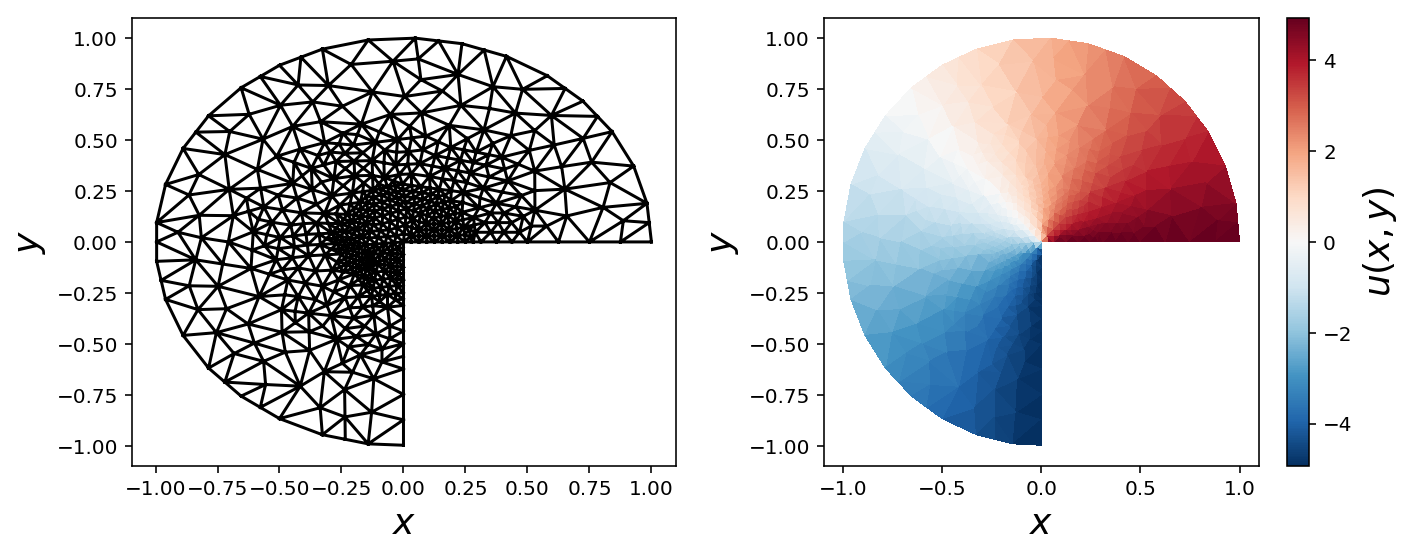
Refined mesh with Dirichlet and von Neumann boundary conditions
mesh = refined_mesh
V = dolfin.FunctionSpace(mesh, 'Lagrange', 1)
u = dolfin.TrialFunction(V)
v = dolfin.TestFunction(V)
boundary_parts = dolfin.MeshFunction("size_t", mesh, mesh.topology().dim()-1)
def v_boundary_func(x, on_boundary):
""" the vertical edge of the mesh, where x = 0 and y < 0"""
x, y = x[0], x[1]
return on_boundary and abs(x) < 1e-4 and y < 0.0
v_boundary = dolfin.AutoSubDomain(v_boundary_func)
v_boundary.mark(boundary_parts, 0)
def h_boundary_func(x, on_boundary):
""" the horizontal edge of the mesh, where y = 0 and x > 0"""
x, y = x[0], x[1]
return on_boundary and abs(y) < 1e-4 and x > 0.0
h_boundary = dolfin.AutoSubDomain(h_boundary_func)
h_boundary.mark(boundary_parts, 1)
def outer_boundary_func(x, on_boundary):
x, y = x[0], x[1]
return on_boundary and abs(x**2 + y**2-1) < 1e-2
outer_boundary = dolfin.AutoSubDomain(outer_boundary_func)
outer_boundary.mark(boundary_parts, 2)
bc = dolfin.DirichletBC(V, dolfin.Constant(0.0), boundary_parts, 2)
a = dolfin.inner(dolfin.nabla_grad(u), dolfin.nabla_grad(v)) * dolfin.dx(domain=mesh, subdomain_data=boundary_parts)
f = dolfin.Constant(0.0)
g_v = dolfin.Constant(-2.0)
g_h = dolfin.Constant(1.0)
L = f * v * dolfin.dx(domain=mesh, subdomain_data=boundary_parts)
L += g_v * v * dolfin.ds(0, domain=mesh, subdomain_data=boundary_parts)
L += g_h * v * dolfin.ds(1, domain=mesh, subdomain_data=boundary_parts)
u_sol = dolfin.Function(V)
dolfin.solve(a == L, u_sol, bc)
Calling FFC just-in-time (JIT) compiler, this may take some time.
/Users/rob/miniconda3/envs/py3.6/lib/python3.6/site-packages/ffc/uflacs/analysis/dependencies.py:61: FutureWarning: Using a non-tuple sequence for multidimensional indexing is deprecated; use `arr[tuple(seq)]` instead of `arr[seq]`. In the future this will be interpreted as an array index, `arr[np.array(seq)]`, which will result either in an error or a different result.
active[targets] = 1
triangulation = mesh_triangulation(mesh)
fig, (ax1, ax2) = plt.subplots(1, 2, figsize=(10, 4))
ax1.triplot(triangulation)
ax1.set_xlabel(r"$x$", fontsize=18)
ax1.set_ylabel(r"$y$", fontsize=18)
data = np.array(u_sol.vector())
norm = mpl.colors.Normalize(-abs(data).max(), abs(data).max())
c = ax2.tripcolor(triangulation, data, norm=norm, cmap=mpl.cm.get_cmap("RdBu_r"))
cb = plt.colorbar(c, ax=ax2)
ax2.set_xlabel(r"$x$", fontsize=18)
ax2.set_ylabel(r"$y$", fontsize=18)
cb.set_label(r"$u(x, y)$", fontsize=18)
cb.set_ticks([-.5, 0, .5])
fig.savefig("ch11-fem-2d-ex5.pdf")
fig.savefig("ch11-fem-2d-ex5.png")
fig.tight_layout()
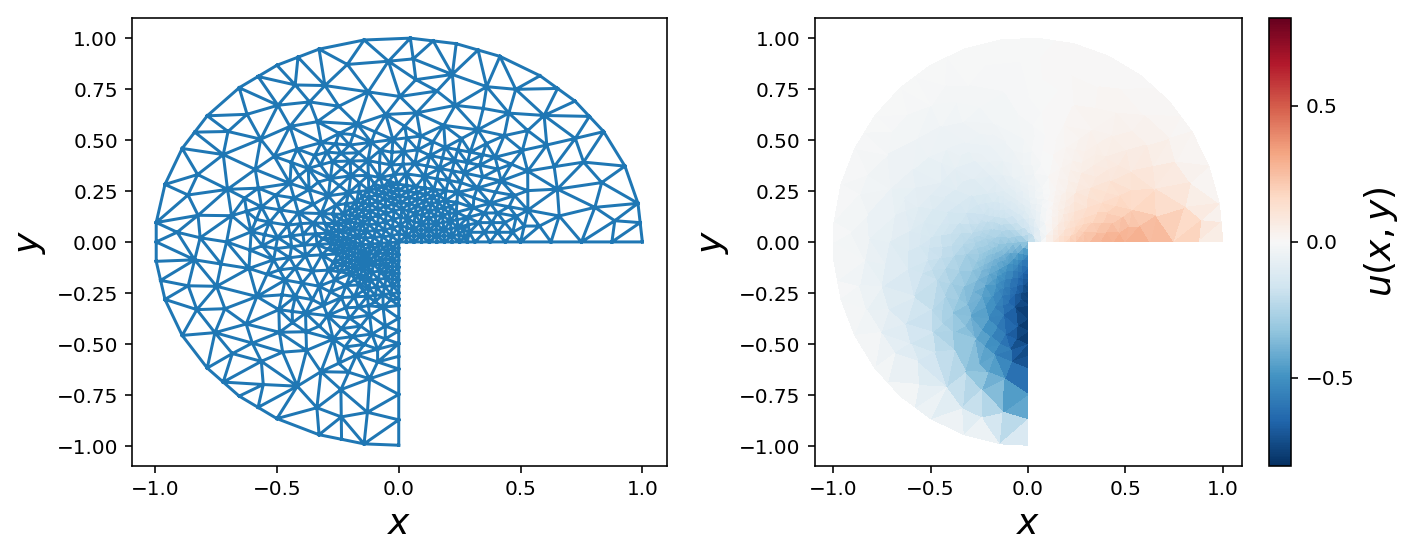
Versions
%reload_ext version_information
%version_information numpy, scipy, matplotlib, dolfin